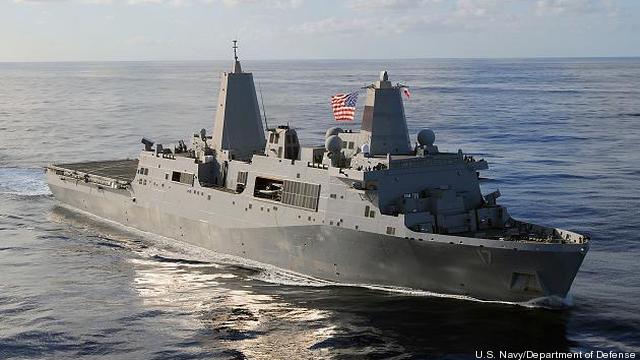HASC Puts Down Payment On 12th LPD — But Will Industry Ever See The Check?
Posted on

The amphibious ship USS San Antonio, LPD-17.
[UPDATED with comment from Seapower Chairman Randy Forbes]
“This is not a slam dunk. This is really the first step.” That’s the cautiously optimistic word from retired Navy captain Brian Schires, chairman of the recently formed Amphibious Warship Industrial Base Coalition (AWIBC), on the $800 million the House Armed Services Committee just authorized towards the construction of a twelfth San Antonio-class amphib — a ship that the Pentagon has not requested.
The HASC is just the first committee out the gate, having passed its version of the 2015 National Defense Authorization Act in the wee hours of Thursday morning. “We really have three significant committees” to go, Schires told reporters on a conference call today. Next up, the Senate Armed Services, Senate Appropriations, and House Appropriations committees. Even if all three agree, what’s in the HASC bill is just a partial payment on the roughly $2 billion cost of a San Antonio (aka LPD-17), Schires acknowledged: “We’d have to count on incremental funding each year.”
So far, in fact, Schires’s company – a division of Rolls-Royce that builds high-tech “controllable-pitch propellers” for the San Antonio class – hasn’t even started serious talks with prime contractor Huntington-Ingalls Industries about props for the proposed ship, which would be designated LPD-28. “We haven’t had those discussions, because the ship wasn’t in the budget for the last couple of years,” he told me. Once negotiations are concluded, it will take two years just to build the actual propellers. But now, he said, HASC has given “some good signs” they’re committed to the ship, despite sequestration.
Overall, Schires sounded pretty confident on the conference call. “[At] my company…we feel like we can now count on an additional ship which provides stability, predictability,” he told reporters. “When you have stability and predictability, that allows you to keep your costs down and your quality up.”
In the longer run, Schires touted the San Antonio design as the natural basis for the next class of amphib the Navy needs to buy to replace aging Harpers’ Ferry and Whidbey Island-class LSDs.“It’s a very flexible hull, particularly from the main deck on down, [that] can easily be transitioned to LX(R),” he said, using the Navy’s placeholder name for the LSD replacement.
Wait a minute, I said: Your coalition happens to be funded by Huntington-Ingalls Industries, but isn’t it supposed to represent the whole industrial base, including HII’s potential competitors for the LSD replacement contract? “There are other ways to meet the LX(R) requirement, and I’ll leave that up to the United States Navy,” Schires said. As far as his company is concerned, he noted, “we have equipment on every US Navy ship… no matter who the shipbuilder is.”
That said, “the LPD-17s [are] coming off the line today. There’s no reason to make this any harder than we have to,” Schires went on. “The LPD just makes sense. It would be a natural fit for the LX(R).”
What does the future really hold for amphibious ships, which are crucial to carrying Marine Corps forces on their missions around the world? We’ll hear Friday morning from HASC seapower subcommittee chairman Randy Forbes, chief architect of that $800 million plus-up.
[UPDATED 9:10 am: So I asked Forbes this morning, what confidence can you give industry that that the 12th San Antonio you found a partial payment for in 2015 — or for that matter the 11 cruisers and one aircraft carrier you found funds to save from mothballs — will get the money to keep going in 2016 and beyond, when sequestration is scheduled to kick back in?
“I can’t guarantee what tomorrow looks like,” Forbes said. “I can only guarantee you what we need to have for tomorrow, [and] we’re going to be with you to help get there.”
“I’m not buying into the fact that sequestration is going to be here. We have to change it — [and] we did get a budget deal that fixed it for a couple of years,” Forbes said. Yes, there’s a fierce debate even among Republicans, he acknowledged, but “at least they changed defense [spending levels] in the budget they had this year, and that’s because of our arguments….We pushed back.”
Industry groups like the Amphibious Warship Industrial Base Coalition have to be part of that push, the Congressman made clear. “Do you think that we need this?” Forbes said. “Is it important that we have it for the national defense of this country? And if it is then you need [to] not just say we’re going to show up and build it, but you’ve got to go out and convince the public and convince policymakers.”]
Subscribe to our newsletter
Promotions, new products and sales. Directly to your inbox.
